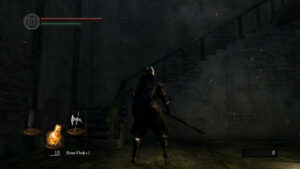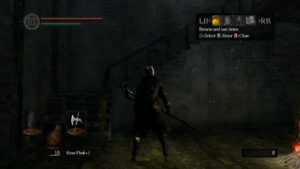Dark Souls: Fire Support
I’ve had a little success in the hunt for NPC assistance: I found a pyromancy trainer! He was, as predicted, in a place I had passed by multiple times, a storeroom where he had been stashed in a barrel by an insane cannibal chef. After rescue, he made his way to the game’s central hub, where I found him and learned my first spell. One thing I had been wondering about: Spells in this game are items of equipment, and one of their attributes is “number of uses”. Did this mean that I would use it up and never be able to cast it again unless I re-purchased it? Or was it like the “Estus Flasks”, the health potions that replenish themselves whenever you either die or sit at a bonfire? I’m relieved to report that the latter is the case. “16 uses” means 16 uses per sally.
But I’ve also had something of a setback: Vamos, the skeletal blacksmith who can upgrade your weapons with magical fire, is dead. This is the result of an accident. He has his forge set up in the Catacombs, in a hall adjacent to a cavern where skeletons stuck to spiked wheels roll around and make a nuisance of themselves. At first, I didn’t understand that these were monsters that needed to be killed, because you can’t easily make out the skeleton part while they’re rolling. Even once you realize this, they’re tricky to catch — they move fast, so when one is temporarily rendered immobile by a wall or something, you have to pounce on it quick before it starts rolling again. Anyway, one of the skeletons managed to roll itself into Vamos’s hallway and get stuck on the anvil, and when I tried poking it with my halberd, I wound up hitting Vamos as well. Vamos did not like this. I tried letting him kill me, in the hope that it would calm him down, but he was still hostile when I returned to the area. So I killed him instead.
As far as I know, I haven’t killed any other peaceful NPCs. I wish it hadn’t happened, but it seems to be permanent. At least he drops some pretty good loot: a cool golden horned helmet with good damage resistances, which has become a permanent part of my wardrobe, and a hammer that does fire damage. Apparently the hammer is considered substandard, but it’s the best I’ve got for melee fire damage, and the best I’m likely to get for a while now that the only smith who can imbue weapons with fire is dead. Thank goodness I’ve got that pyromancy trainer around. I’ll try not to kill him too.
 Comments(1)
Comments(1)
